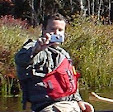When I was in second grade my father took a job up in New Hampshire. We lived in a small apartment in the city of Dover, and spent most of the summer at a seasonal campsite nearby. I remember swimming in the lake and sitting around the campfire at night, but other than marshmallows and the occasional hot dog on a stick, cooking was always done on the camp stove.
 |
| Omelets on the stove |
When I started canoe camping the camp stove came with me. For some trips freeze-dried food cooked with a Jet Boil stove was the order of the day. For other trips we loaded up coolers with fresh food, but when I was the chef the cooking was always done on the camp stove.
For some of my friends, though, cooking in camp means cooking over an open fire. Jonathan is a good example. He will often look at the simple fire ring that is the staple at many campsites with a bit of disgust. If he is planning to cook on the fire, he will deconstruct old fire ring and rebuild it in a “U” shape about 8” to 10” tall and just wide enough to support the grill.
 |
| Sausage and foil-pack potatoes |
When a campfire cook has passed through a campsite you can always tell by the fire pit. The pit will be clear of ash and debris allowing ample room for wood under the grill. If it is round, it will be large with multiple cooking spots depending on the type of cooking to be done and the heat needed. Or like Jonathan’s, it will be “U” shaped.
I’ve leaned that a critical part of campfire cooking is having the right wood. Firewood should be collected selectively to leave the site and scenery as undisturbed as possible. Softwoods are usually the easiest to find and burn the fastest. Hardwoods produce a cleaner, longer lasting fire and better coals.
 |
| Cooking on the Big Daddy |
Anything you can cook on the stove you can cook on the fire, but it takes the right equipment and some patience. The most important part of the cooking fire is the height of the grill – too low and it will be tough to get wood underneath, too high and it will take a lot of wood to produce enough heat. A grill grate at 8” to 10” seems to work best.
You will also need pots, pans and utensils. A good frying pan and large pot are essential for group meals. For cooking, keep the fire contained under the pots and pans. You will also need a knife, spatula, serving spoon and tongs. Long handles make it easy to work around the fire, and fireproof gloves are a nice addition.
 |
| Grilling salmon and vegetables |
The type of fire that you build will depend on the type of cooking you are doing. Grilling directly over the fire requires a nice bed of hot coals, so get the fire going early or you might be eating late. Foil packs are an easy way to cook fish, potatoes and vegetables, but are also easier on a well-developed bed of coals. Be sure to turn the food often since hot spots can develop and burn the food if you are not careful.
Cooking in pans is easier, and you can cook directly over the fire without having to wait for coals. Shift the pans around to get the heat that you need and prevent hot spots. Patience is still required since temperatures on the fire don’t match those generated on the stove.
 |
| Dutch oven cooking |
The dutch oven is one of my favorite ways to cook in camp. Anything you can cook in your oven at home you can cook in a dutch oven - frittata or cinnamon rolls for breakfast; enchiladas, lasagna or chicken and biscuits for dinner; monkey bread, brownies or dump cake for desert. The trick to cooking in a dutch oven is balancing the heat on the top and the bottom, and regulating the temperature. Regulating the temperature is much easier with charcoal than with coals from the fire, so I usually bring it long.
No doubt about it, cooking is one of the joys of camping, and cooking over the open fire takes it to the next level.
 |
| Breakfast fire |
Links:









No comments:
Post a Comment
Note: Only a member of this blog may post a comment.